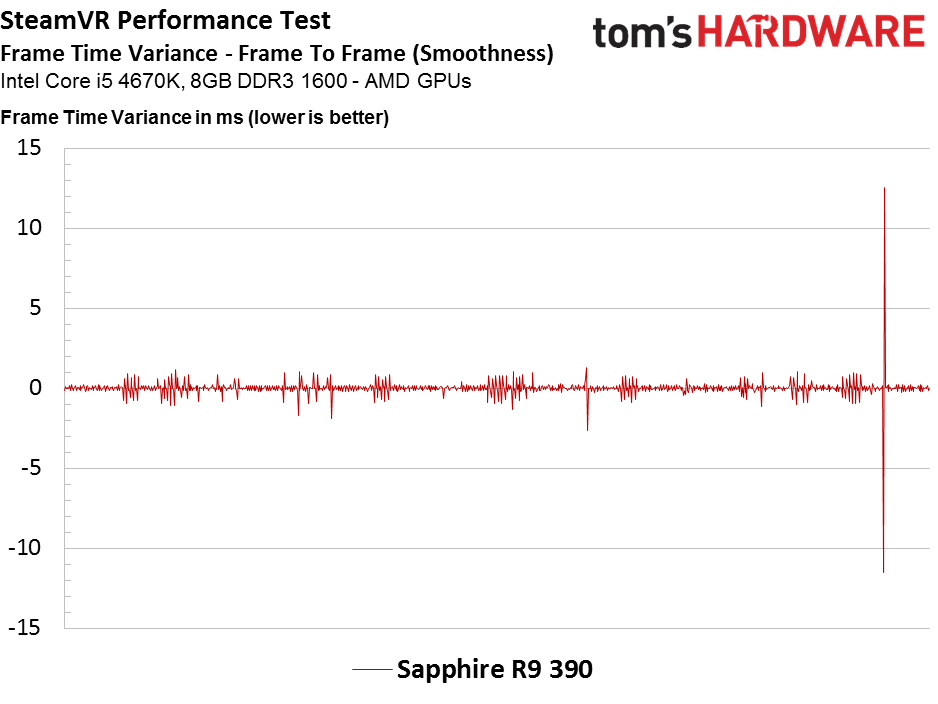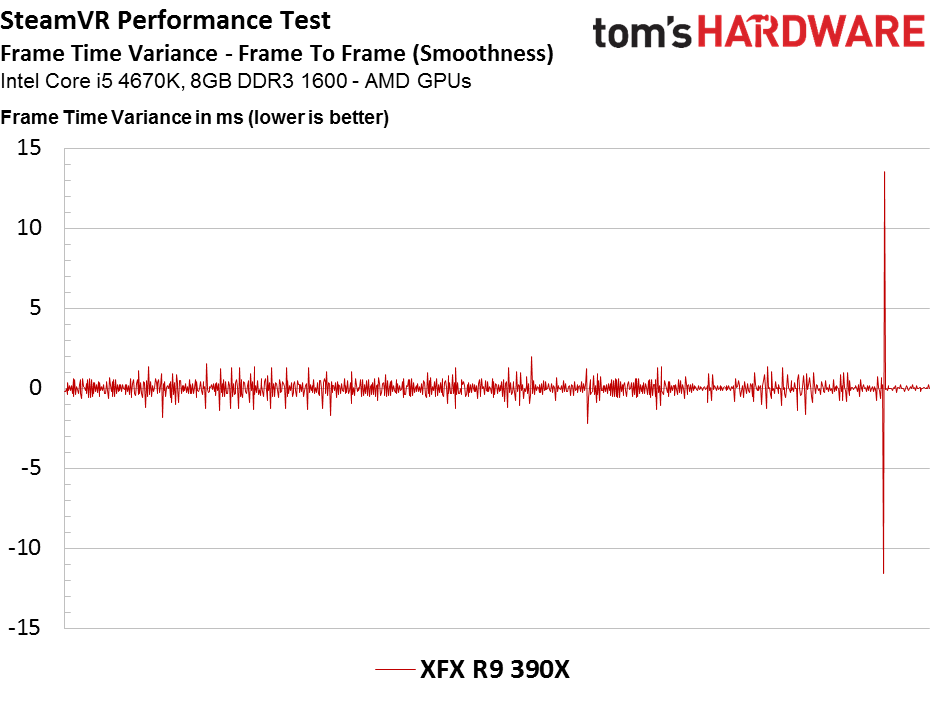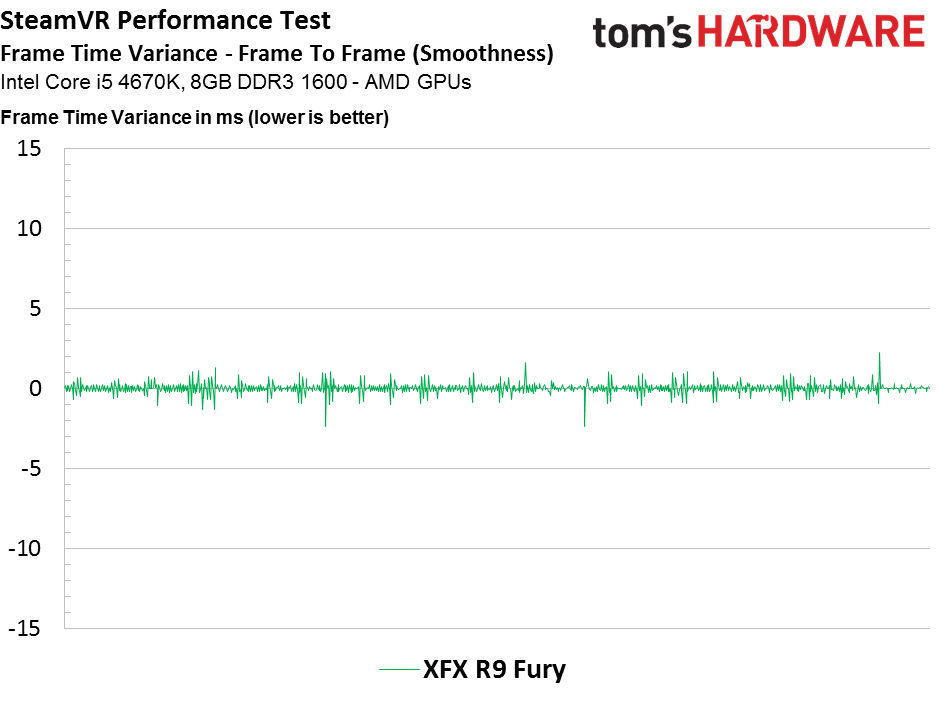SteamVR Performance Test: 16 GPUs Compared
Last week, Valve released its SteamVR Performance Test. We just finished testing 16 GPUs in order to determine what you really need for a VR-ready gaming PC.
Ready For VR And Final Thoughts
You'll almost certainly spend more money, but there are plenty of options better suited for VR gaming. AMD offers its R9 390 and R9 390X with 8GB of GDDR5, as well as its Fiji family: the Fury, Fury X and Nano. Nvidia has the GTX 970, 980, 980 Ti and Titan X based on GM204 and GM200.


Our R9 390 from Sapphire performs admirably, returning a score of 7.1 at high fidelity. XFX's R9 390X isn't far off, again treating us to high fidelity, this time with a score of 7.6.
Both of those cards outmode Nvidia's entry-level VR-ready GeForce GTX 970. Our Gigabyte GTX 970 WindForce OC manages high fidelity, but achieves a slightly lower score of 6.9.
The XFX R9 Fury is a notable step up from the R9 300 series. Armed with a Fiji GPU, our test system kicks out an average fidelity rating of 8.5. Nvidia's GeForce GTX 980, represented by Asus' Matrix Platinum model, fares slightly better with a score of 8.9.
Our selection of CrossFire-capable combinations is limited, but we do have a couple of R9 390Xes and a Radeon R9 295X2. Curiously, though, CrossFire doesn't seem to work correctly with either configuration. We double-checked the settings and reran the test, but the R9 295X2 only scores 7.1, while the R9 390Xes manage a 7.6. Those numbers are only good enough for high, not very high fidelity.
The GTX 980 Ti AMP! Extreme is by far the best-performing card in our stable. It earns a score of 11 by maneuvering through the test with very high fidelity. In SLI, two GTX 980 Tis maintain the same score and rating. As far as we can tell, two GM200s don't seem to suffer the same ill effects as the lower-end cards in SLI.
FRAPS Analysis
The results we generated using the SteamVR Performance Test are helpful for generally evaluating performance in VR apps, but they aren't as granular as some of the numbers you'd expect to see in a Tom's Hardware graphics card review. We don't see how high frame rates go. Rather, we only see how often they dip below 90 FPS. For a bit more insight, we ran FRAPS during each test to get a better sense how each card behaves.
Get Tom's Hardware's best news and in-depth reviews, straight to your inbox.


It's widely known that the target frame rate for VR content is higher than a typical game played on a desktop monitor. We're accustomed to using numbers between 30 and 60 FPS when we talk about smooth-enough performance. VR requires at least 90 FPS to maintain fluidity that doesn't trigger motion sickness. The higher your frame rate, the more of a buffer you have when the graphics workload intensifies. That's the primary reason you want a high-end PC for running virtual reality games.
The SteamVR Performance Test looks like it wants to keep minimum frame rates above 100. That's a decent target in case you're hit with a sequence that forces performance down momentarily. Of course, more potent graphics subsystems facilitate even better frame rates, padding that buffer substantially. The GeForce GTX 980 Ti, for instance, sustains frame rates above 140 FPS, peaking north of 180 FPS.
Our FRAPS data also suggests that AMD's cards tend to have more regulated frame rates. You can see from the minimum and maximum frame rate graphs that AMD GPUs target the minimum frame rate more accurately at 100 FPS across the board. In comparison, Nvidia seems to favor a higher minimum frame rate. But this data doesn't tell the full story.
















You have to look at the frame time variance data to see how much fluctuation there is between rendered frames. Less variance should translate to a smoother VR experience.
Final Thoughts
The SteamVR Performance Test is an interesting metric, particularly for those wondering if their PC is ready to tackle VR. But the way it conveys results and the wording it uses can be difficult to interpret. It's self-defeating to describe a platform as "capable" of VR playback when your target audience is already spending a small fortune on a VR HMD. Supporting hardware barely able to stumble over the finish line is bound to under-serve the experience. At worst, you risk subjecting early adopters to a sub-standard first look at VR. That's the last thing the industry needs as it finds its wings.
No doubt, virtual reality is the next big thing in gaming. But as we've seen so many times before, the enthusiasts with deep pockets are the ones who get to play first. If your PC doesn't have what it takes to earn a "ready" score, then do yourself a favor and wait to invest in a VR HMD. The right graphics subsystem, especially, makes all the difference in satisfying the ecosystem's lofty recommended specs.
MORE: Virtual Reality Basics
MORE: AMD's LiquidVR Puts Processing Muscle Behind Virtual Reality
MORE: Nvidia GameWorks VR Multi-Res Shading And Other Parlor Tricks
Kevin Carbotte is a Contributing Writer for Tom's Hardware, covering Graphics. Follow him on Twitter.
Kevin Carbotte is a contributing writer for Tom's Hardware who primarily covers VR and AR hardware. He has been writing for us for more than four years.
-
dark_lord69 Thanks, these are performance benchmarks I wanted to see!Reply
It answers several questions I had... -
TechyInAZ Good read.Reply
With how expensive VR headsets are right now, I don't understand why you would pair it with such a budget friendly GPU in the first place. If you can pay $500 for a VR headset, you should be able to buy at least a GTX 970 too. -
turkey3_scratch You could buy well more than a GTX 970. For a true VR experience, for the most immersive, I think you will want a GTX 980 minimum, preferably an R9 Nano to 980Ti. Any type of slight frame drop is a major loss of immersion.Reply -
TechyInAZ Reply17636098 said:You could buy well more than a GTX 970. For a true VR experience, for the most immersive, I think you will want a GTX 980 minimum, preferably an R9 Nano to 980Ti. Any type of slight frame drop is a major loss of immersion.
I would probably favor the Fury Nano or Fury over a 980 since VR headsets have very high res displays. -
turkey3_scratch Yep. 980 is such a bad value IMO. The 390X value isn't too good either. The R9 Nano is the only card above the GTX 970 and R9 390 that seems to have good value IMO.Reply -
moogleslam Because I have an i7-2600k (running at 4.8Ghz), I apparently don't meet the minimum requirements for Oculus Rift. Really?Reply -
lun471k ReplyBecause I have an i7-2600k (running at 4.8Ghz), I apparently don't meet the minimum requirements for Oculus Rift. Really?
They don't really bother checking your CPU. If it's older gen, they automatically assume it sucks. funny thing is that I also run a 2600k @ 4.8Ghz and even systemrequirementslab says my CPU can't run latest games (not in VR). Yet I play everything on Ultra... -
rainyfeels Is some of this based off architecture? My 780 is superclocked and can easily compete with a 970 yet only gets 4.5 in the test and is "capable". Or will it be fine when it actually comes to playing games?Reply -
kcarbotte Reply17636075 said:Thanks, these are performance benchmarks I wanted to see!
It answers several questions I had...
I'm glad you liked it.
It was quite an effort to do, but I felt it was info that people would want to know.
